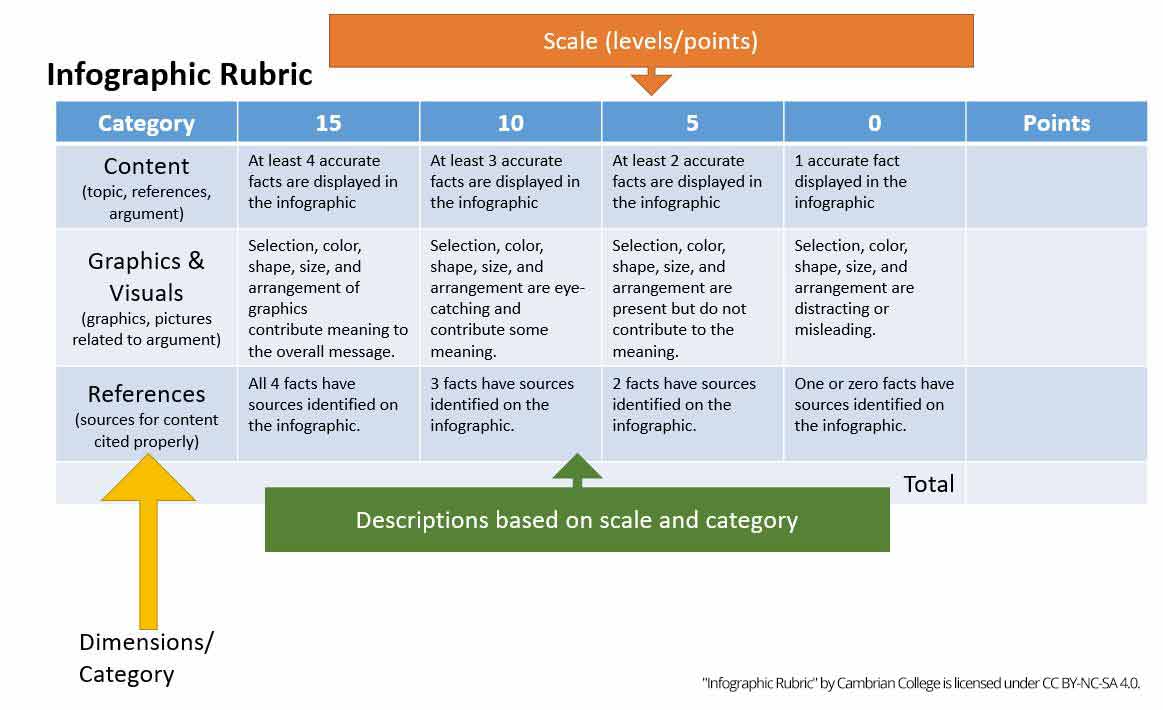Evaluating Assessment: Rubrics
When it comes to evaluating learner assessments, rubrics are the best way to assess demonstrations or artefacts to a common standard, while clearly communicating expectations to learners. Rubrics can reduce subjective judgment that can occur during evaluations, while providing more feedback than possible to write in the short time teachers have.
There are three main types of rubrics. For each of the following rubrics, you will see an example provided based on an infographic assignment.
Analytic
Separates the characteristics of an assignment into parts, allowing the instructor to categorize and define exactly what each level of achievement looks like. This type of rubric can be built directly into Blackboard Ultra.

| Category | 15 | 10 | 5 | 0 | Points |
|---|---|---|---|---|---|
| Content (topic, references, argument) | At least 4 accurate facts are displayed in the infographic | At least 3 accurate facts are displayed in the infographic | At least 2 accurate facts are displayed in the infographic | 1 accurate fact displayed in the infographic | |
| Graphics & Visuals (graphics, pictures related to argument) | Selection, color, shape, size, and arrangement of graphics contribute meaning to the overall message. | Selection, color, shape, size, and arrangement are eye-catching and contribute some meaning. | Selection, color, shape, size, and arrangement are present but do not contribute to the meaning. | Selection, color, shape, size, and arrangement are distracting or misleading. | |
| References (sources for content cited properly) | All 4 facts have sources identified on the infographic. | 3 facts have sources identified on the infographic. | 2 facts have sources identified on the infographic. | One or zero facts have sources identified on the infographic. | |
| Total | |||||
- The numbers in the top heading, 0-15, represent the scale (levels/points)
- The cells under the scale are the descriptions based on scale and category.
- The Category column represent the dimensions/category
Holistic
Assesses learners’ overall performance on an activity or assessment based on a single scale using predefined achievement levels.
| Scale | Criteria |
|---|---|
| 4 |
|
| 3 |
|
| 2 |
|
| 1 |
|
Adapted from “Infographic Holistic Rubric” by Cambrian College is licensed under CC BY-NC-SA 4.0.

| Scale | Criteria |
|---|---|
| 4 |
|
| 3 |
|
| 2 |
|
| 1 |
|
If you would like to build a holistic rubric, you cannot build it directly into Blackboard Ultra. The best approach is to share your rubric in PDF format, attached to the assignment instructions in Blackboard. You can then attach your completed rubric to your feedback in Ultra. Here is a .docx template of a holistic rubric for your use.
Download the Holistic Rubric Template (DOCX, 21 KB)
Single-Point
Outlines the success criteria for an assessment; however it leaves room on either side of the criteria for written feedback about meeting expectations and areas for improvement.
| Concerns (Areas that need improvement) | Criteria (Standards for this Assessment) | Strengths (Evidence of Exceeding Standards) |
|---|---|---|
|
Design
|
||
|
Content
|
Adapted from “Single-Point Rubric” by Cambrian College is licensed under CC BY-NC-SA 4.0.
If you would like to build a single-point rubric, you cannot build it directly into Blackboard Ultra. As with the holistic rubric, the best approach is to share your rubric in PDF format, attached to the assignment instructions in Blackboard. You can then attach your completed rubric to your feedback in Ultra. Here is a .docx template of a single-point rubric for your use.
